|


Agriculture is the science of farming, which
is raising crops like corn, beans, peas, safflowers, soybeans and also
raising animals like
cows, sheep, pigs, goats and chickens.

Farming is VERY important and it probably affects you in
more ways than you know. Look below at what is used to make a lot
of the food and products that you need everyday!
|
 |
 Wheat is the main food that we eat everyday and it
is the most important crop in the world! In fact, if you
studied all of your food long enough, you might just realize that
almost everything contains wheat in one form or another. Think
about these examples: breakfast cereals, breads, all pastas like the noodles
in spaghetti and even the noodles in Chicken Noodle Soup,
bagels, cakes and pastries like donuts or even cookies. Flour is actually in almost
everything that we eat except for fruits and vegetables! Wheat
can also be used in place of petroleum in plastics, which can then
be made into just about anything from toys to the inside of a real
car. Wheat is the main food that we eat everyday and it
is the most important crop in the world! In fact, if you
studied all of your food long enough, you might just realize that
almost everything contains wheat in one form or another. Think
about these examples: breakfast cereals, breads, all pastas like the noodles
in spaghetti and even the noodles in Chicken Noodle Soup,
bagels, cakes and pastries like donuts or even cookies. Flour is actually in almost
everything that we eat except for fruits and vegetables! Wheat
can also be used in place of petroleum in plastics, which can then
be made into just about anything from toys to the inside of a real
car.
|
|
 |
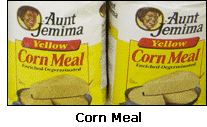 Corn
is a popular crop all over the world. It will grow in hot
climates and also cooler, mild ones as long as there is lots of sunshine. Do you recognize some of these
things that are made with corn: breakfast cereals, baby foods,
almost ALL candy has corn starch in it to add that sweet flavor,
carbonated beverages or what is also known as pop contains a high frutose
corn syrup, cornmeal is used in breads, muffins and as the breading
on meats like fried chicken, instant coffee and soup mixes as
well as a lot of other things in packages contain Corn
is a popular crop all over the world. It will grow in hot
climates and also cooler, mild ones as long as there is lots of sunshine. Do you recognize some of these
things that are made with corn: breakfast cereals, baby foods,
almost ALL candy has corn starch in it to add that sweet flavor,
carbonated beverages or what is also known as pop contains a high frutose
corn syrup, cornmeal is used in breads, muffins and as the breading
on meats like fried chicken, instant coffee and soup mixes as
well as a lot of other things in packages contain
 maltodextrins
which comes from corn and helps to keep the dry mix from clumping
together, pyrodextrin another agent from corn is used to help make tape and
other things sticky, and lastly something in corn called sorbitol is
even found in your toothpaste. maltodextrins
which comes from corn and helps to keep the dry mix from clumping
together, pyrodextrin another agent from corn is used to help make tape and
other things sticky, and lastly something in corn called sorbitol is
even found in your toothpaste. |
|
 |
 Rice is another very important crop just like wheat
and corn. It is a main food for over half of the world's
population and 99% of all rice is grown in Asia. Some of the
things made out of rice are cereals like Rice Krispies along with
those "YUMMY" Rice Krispy Treats, some noodles,
rice pudding, rice milk for people who can't drink regular cow's
milk, some crackers, and you can even buy cinnamon raisin rolls,
bagels, buns and bread that is free of wheat, gluten and lactose,
which means that it is instead made from rice flour! There is even
such a thing as
paper that is made from rice. Rice is another very important crop just like wheat
and corn. It is a main food for over half of the world's
population and 99% of all rice is grown in Asia. Some of the
things made out of rice are cereals like Rice Krispies along with
those "YUMMY" Rice Krispy Treats, some noodles,
rice pudding, rice milk for people who can't drink regular cow's
milk, some crackers, and you can even buy cinnamon raisin rolls,
bagels, buns and bread that is free of wheat, gluten and lactose,
which means that it is instead made from rice flour! There is even
such a thing as
paper that is made from rice. |
|
 |
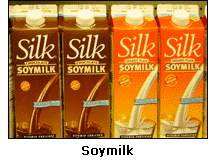 Peas, beans and lentils are edible seeds that grow
in a pod on a plant and they contain lots of protein and vitamins.
You have more than likely eaten a variety of beans fresh or dried in
soups, but one bean that when processed and added to other
ingredients becomes very useful is soybeans. Soybeans turn up in
soap, paper, paint, video tapes, ink, baby food, tofu, cereals,
bread, cookies, frozen dinners, and even in pizza. In fact,
Illinois is the second largest producer and they grow enough
soybeans in one year to fill 118,000 school buses. Here is a
picture of soymilk, which is the only kind of milk that lactose
intolerant people can drink because regular cow's milk makes them
sick. Peas, beans and lentils are edible seeds that grow
in a pod on a plant and they contain lots of protein and vitamins.
You have more than likely eaten a variety of beans fresh or dried in
soups, but one bean that when processed and added to other
ingredients becomes very useful is soybeans. Soybeans turn up in
soap, paper, paint, video tapes, ink, baby food, tofu, cereals,
bread, cookies, frozen dinners, and even in pizza. In fact,
Illinois is the second largest producer and they grow enough
soybeans in one year to fill 118,000 school buses. Here is a
picture of soymilk, which is the only kind of milk that lactose
intolerant people can drink because regular cow's milk makes them
sick. |
|
 |
 Sugar
comes from sugarcane and sugar beets. Sugarcane grows best
where it is warm, whereas sugar beets grow best in places like
Montana and North Dakota
where it is warm in the summer and cold in the winter. The
beets are pulled in the fall when it starts to get cold and taken to
the local Sidney Sugars factory, where they are cleans and boiled. All
that is left then are brown sugar crystals, which go through yet another
process to make the white sugar used in cookies and candy.
Here is a picture of some sugar that came from the the local factory
in Sidney. Sugar
comes from sugarcane and sugar beets. Sugarcane grows best
where it is warm, whereas sugar beets grow best in places like
Montana and North Dakota
where it is warm in the summer and cold in the winter. The
beets are pulled in the fall when it starts to get cold and taken to
the local Sidney Sugars factory, where they are cleans and boiled. All
that is left then are brown sugar crystals, which go through yet another
process to make the white sugar used in cookies and candy.
Here is a picture of some sugar that came from the the local factory
in Sidney. |
|
 |
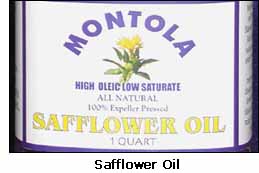 Vegetables
oils are made from seeds and fruits like
tiny sesame seeds or big, juicy coconuts. Oils such as peanut
oil, cottonseed oil, sunflower oil, canola oil, corn oil, safflower oil, soybean oil, and olive oil are
used for such things as cooking, as dressings on a salad, and in
margarine and cooking fats. Like wheat, vegetable oils are in
a lot more things than you might think. Olive oil has been for
a long time the best oil for you because even though it
contains fat it is the monounsaturated or "good" fat.
Having lots of "good" fat in your diet instead of the saturated or
"bad" fats, will help to keep you healthy and strong.
But now olive oil is having to step aside because of research being
done in Eastern Montana that has led to the development of a new
safflower oil that is even better for you. Montola oil,
pictured here, was developed by Montana State University researchers
and is made and produced from safflower grown right here in Eastern
Montana. Vegetables
oils are made from seeds and fruits like
tiny sesame seeds or big, juicy coconuts. Oils such as peanut
oil, cottonseed oil, sunflower oil, canola oil, corn oil, safflower oil, soybean oil, and olive oil are
used for such things as cooking, as dressings on a salad, and in
margarine and cooking fats. Like wheat, vegetable oils are in
a lot more things than you might think. Olive oil has been for
a long time the best oil for you because even though it
contains fat it is the monounsaturated or "good" fat.
Having lots of "good" fat in your diet instead of the saturated or
"bad" fats, will help to keep you healthy and strong.
But now olive oil is having to step aside because of research being
done in Eastern Montana that has led to the development of a new
safflower oil that is even better for you. Montola oil,
pictured here, was developed by Montana State University researchers
and is made and produced from safflower grown right here in Eastern
Montana. |
|
 |
 Cattle
are very popular animals because they provide us with meat, which
is called beef, and also milk. Milk contains necessary nutrients such as calcium and protein
and it is used to make foods called dairy products like cheese, cottage
cheese, butter, yogurt, and cream. Some other foods that are
made with dairy products are: almost all desserts like Cattle
are very popular animals because they provide us with meat, which
is called beef, and also milk. Milk contains necessary nutrients such as calcium and protein
and it is used to make foods called dairy products like cheese, cottage
cheese, butter, yogurt, and cream. Some other foods that are
made with dairy products are: almost all desserts like
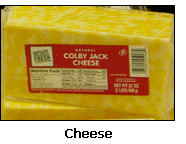 cookies,
cakes, chocolate, and ice cream, most hot dishes have either some
milk or cheese in them along with some soups
like tomato soup, bread has milk in it even though you can't see
it like the milk in your cereal.
Probably most of the meat that you eat comes from cattle, too, like
your
hamburger and steaks. Try this: for one day before
you eat something think
about whether it contains milk or meat from cattle. You will
more than likely be really surprised and might even loose track
counting because there are so many foods that are made possible by
cattle. cookies,
cakes, chocolate, and ice cream, most hot dishes have either some
milk or cheese in them along with some soups
like tomato soup, bread has milk in it even though you can't see
it like the milk in your cereal.
Probably most of the meat that you eat comes from cattle, too, like
your
hamburger and steaks. Try this: for one day before
you eat something think
about whether it contains milk or meat from cattle. You will
more than likely be really surprised and might even loose track
counting because there are so many foods that are made possible by
cattle. |
|
 |
 Sheep
are raised for their meat and for the foods and other products that can be made from their milk and wool.
Just like with cow's milk,
such things like cheese and yogurt are made from sheep milk. Clothing is made from their wool, as well as ointment and hand creams
from the oil in the wool. Are you wearing anything that is
made out of wool? If so, then you're wearing a sheep! Sheep
are raised for their meat and for the foods and other products that can be made from their milk and wool.
Just like with cow's milk,
such things like cheese and yogurt are made from sheep milk. Clothing is made from their wool, as well as ointment and hand creams
from the oil in the wool. Are you wearing anything that is
made out of wool? If so, then you're wearing a sheep! |
|
 |
Pigs are used mainly for their meat, especially in
China were most of the pigs in the world are kept. Meats that
you've probably eaten which come from pigs are: ham, sausage, bacon,
and pork chops.
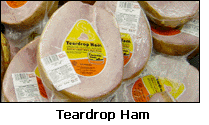  |
|
 |
Chickens are raised by farmers for their eggs and later their meat.
Hens, which are female chickens, can produce between 250-300 eggs a
year. The eggs that we eat are gathered soon after the
chickens lay them so there are no
 baby chickens inside.
Eggs are used
in a lot of baked goods like cookies, cakes, breads, and brownies,
but when most people think of eggs they think of breakfast foods
like omelets and scrambled eggs. baby chickens inside.
Eggs are used
in a lot of baked goods like cookies, cakes, breads, and brownies,
but when most people think of eggs they think of breakfast foods
like omelets and scrambled eggs.
|

Underground vegetables are plants that we grow for the part that is
beneath the soil. Carrots, turnips, radishes, and parsnips are the
"fat" roots of plants and these are called root vegetables.
Potatoes are the "swollen" part of the underground stem of a potato
plant, which is known as tubers. Onions, are in between, because
it is the bulb underneath the plant that we eat.
|
Underground vegetables: |
 |
 |
|
Carrots & Turnips |
Onions & Potatoes |
 Hothouse
vegetables are vegetables that have to be grown in hot climates like
peppers, tomatoes, cucumbers, eggplant, and zucchini. A farmer
grows them inside a special building with glass or clear plastic walls
and by doing this they can even grow them year around. Hothouse
vegetables are vegetables that have to be grown in hot climates like
peppers, tomatoes, cucumbers, eggplant, and zucchini. A farmer
grows them inside a special building with glass or clear plastic walls
and by doing this they can even grow them year around.
The peppers pictured at the right are
called bell peppers and their are a total of 6 different types.
Can you name them all?
answer: yellow, red,
green, orange, brown & purple |
|
|

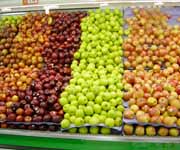 |
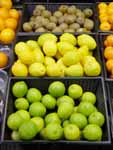 |
 |
|
Tree fruits |
Citrus fruits |
Tropical fruits |
Tree fruits are simply fruits that grow
on trees, and they can come in many different forms from crisp apples, soft
and juicy peaches, or crunchy nuts. In moderate climates, apples
are the most widely grown fruit.
Citrus fruits are different than tree
fruits, because they have to be grown in tropical and subtropical
climates. Some citrus fruits are oranges, grapefruits, tangerines,
lemons and limes.
Lastly, tropical fruits are only grown in
climates that are hot and wet. Bananas and pineapple are the two
tropical fruits that you are probably the most familiar with, but kiwifruit, passion fruit, star fruit, mangos and papayas
are also examples of tropical fruits. |
